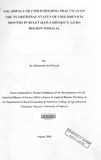| dc.description.abstract | Despite food ration distribution, presence of feeding programmes and provision of free health
care, during emergencies, malnutrition and morbidity persist and constitute a threat to child
survival, growth and development in Somalia. In this regard factors responsible for affecting
child health and nutritional status namely; morbidity, mortality and food consumption
patterns in Belet-hawa district of Somalia, have been investigated by Food Security and
Nutrition Analysis Unit (FSNAU) of Food and Agriculture Organization (FAO) and other
agencies. However, none of the studies has focused on child care and the feeding practices.
Accordingly, the study on the influence of feeding practices on child nutritional status was
carried out in Beled-Hawa district. The study was cross sectional and descriptive in nature.
The main objective of the study was to assess the effect of breastfeeding and complimentary
feeding practices' on the nutritional status of children aged 0-24 months in Belet Hawa
District.
Multi-stage sampling technique was employed to obtain the targeted number of children. A
total of 294 children aged between 0-24 months, their mothers and caregivers constituted the
study group. All mothers or caregivers of participating children were interviewed. Data on
socio-economic, demographic and socio-cultural factors, as well as the feeding practices on
breastfeeding and complimentary feeding were collected. The nutritional status of the
children was assessed by measuring child's height and weight, and presence of edema.
Structured questionnaire was used as the tool to collect the data. Focus group discussions, key
informant interviews and observation were used to validate the information obtained.
The study on GAM (weight for height <-2 Z scores or oedema) of23.5% (21.1 - 26.7) and a
high level (3.8%) of severe acute malnutrition, demonstrated a severe malnutrition status in
the district. This study also showed that malnutrition varied with age, where children aged 18
- 24 months were more severely malnourished compared with those aged 6 - 11 and 12 - 17
months (p < 0.05). The highest proportion of malnourished children in all nutritional indices
was between ages of 18-24 months. It was found out that there was a strong association
between underweight and child sex (p < 0.05), with more girls being underweight as
compared with boys. However, child sex was not associated (p < 0.05) with the wasting and
stunting status. The results also showed that small percentage (21 %) of children who were
bottle fed in Beled-hawa district were significantly associated with improved nutritional
status of children (P <0.05). It was also established that children who were fed with fluids
other then breast milk in the first three days of life were at risk of being malnourished
compared to those who were fed with breast milk only (P < 0.05). There was significant
association of frequency of feeding of children 6-24 months old with their nutritional status in
this study (P < 0.05).
The relationship between breastfeeding practices and social econornic/socio-demographic
variables was significant (p < 0.05). Breastfeeding practices of mothers were significantly
influenced (p < 0.05) by level of education of the mother, her marital status, area of
residence, animal owned by the family and the age of the child. However, complementary
feeding practices were not significantly associated with any of the socio-economic and sociodemographic
factors.
It was concluded that the malnutrition rate (23.5%), was very high and alarming in Belet-
Hawa district. The nutritional status of children was significantly positively associated with
bottle feeding, and negatively influenced by pre-lacteal feeding and frequency of feeding, of
children in Beled-Hawa district (P < 0.05). The breastfeeding practices of mothers were
strongly influenced by their area of residence, level of education, marital status of the mother,
animal owned by the family and the age of the child. However, in this study, the socioeconomic
and socio-demographic factors were not associated (p > 0.05) with the
complementary feeding practices of mothers.
From this study it is recommended that health and nutrition education activities be intensified
targeting mothers, and other caregivers at the household level, in order to address care
concerns. The main areas of focus should include promoting exclusive-breastfeeding,
appropriate young child feeding, and diet diversification. To overcome the many barriers of
breastfeeding and optimal complimentary feeding practices, there is a need for input from
health professionals and voluntary workers, and a positive environment. As high levels of
malnutrition have been seen throughout the study population, it is highly recommended that
the local MCHs / local health personnel be well equipped with the knowledge and skills to
manage severe malnutrition both during and outside periods of crisis. | en |

